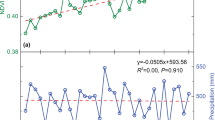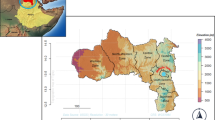Abstract
Climate variability and climate extremes are important climatic determinants of plant growth, species distribution and net primary productivity. A comprehensively quantitative analysis of the sensitivity and resilience of ecosystems to climate variability is vital to identify which regions and species are most in danger in response to future climate change. Here, we proposed an empirical approach to assess the relative sensitivity and resilience of ecosystems to short-term climate variability in the Heihe River Basin (HRB) which is the second largest inland river basin in the northern China and contains ecosystems of semi-arid, arid and hyper-arid types. Based on the monthly time series of normalized difference vegetation index (NDVI), land surface temperatures (LST) and the ratio of actual evapotranspiration to potential evapotranspiration (AET/PET) derived from MODIS sensor from 2000 to 2013, we developed a multiple linear regressive and autoregressive model to determine the sensitivity of NDVI anomalies to climate variability indicated by monthly LST anomalies (temperature variability) and monthly AET/PET anomalies (water variability). We included 1 month time lag of NDVI anomalies in order to reflect ecosystem resilience. We found that the sensitivity and resilience to climate variability were different in the upper, middle and lower reaches of the HRB. Temperature variability dominantly controlled vegetation anomalies in the upper reach, but water variability was the dominant climatic factor in the middle and lower reaches. The different responses of semi-arid to hyper-arid ecosystems to climate variability depended much on the distinct climatic conditions and diverse vegetation types. Ecosystems in drier condition tended to show higher sensitivity to water variability, and ecosystems with colder climate were likely to be more sensitive to temperature variability. The most sensitive vegetation type to water variability and temperature variability in the HRB was crop and meadow, respectively. Grass had been proved to have the lowest resilience. Our research on the sensitivity and resilience of semi-arid to hyper-arid ecosystems is helpful for formulating and implementing adaptation and mitigation strategies in response to climate change.











Similar content being viewed by others
References
Ahlstrom A et al (2015) The dominant role of semi-arid ecosystems in the trend and variability of the land CO2 sink. Science 348:895–899
Allen CD et al (2010) A global overview of drought and heat-induced tree mortality reveals emerging climate change risks for forests. Forest Ecol Manag 259:660–684
Bartholomeus RP, Witte J-PM, van Bodegom PM, van Dam JC, de Becker P, Aerts R (2012) Process-based proxy of oxygen stress surpasses indirect ones in predicting vegetation characteristics. Ecohydrology 5:746–758
Campos GEP et al (2013) Ecosystem resilience despite large-scale altered hydroclimatic conditions. Nature 494:349–352
Ciais P et al (2005) Europe-wide reduction in primary productivity caused by the heat and drought in 2003. Nature 437:529–533
Cong N, Wang T, Nan H, Ma Y, Wang X, Myneni RB, Piao S (2013) Changes in satellite-derived spring vegetation green-up date and its linkage to climate in China from 1982 to 2010: a multimethod analysis. Global Change Biol 19:881–891
De Keersmaecker W, Lhermitte S, Tits L, Honnay O, Somers B, Coppin P (2015) A model quantifying global vegetation resistance and resilience to short-term climate anomalies and their relationship with vegetation cover. Global Ecol Biogeogr 24:539–548. https://doi.org/10.1111/geb.12279
Garcia RA, Cabeza M, Rahbek C, Araujo MB (2014) Multiple dimensions of climate change and their implications for biodiversity. Science 344:1247579
Gessner U, Naeimi V, Klein I, Kuenzer C, Klein D, Dech S (2013) The relationship between precipitation anomalies and satellite-derived vegetation activity in Central Asia. Global Planet Change 110:74–87
Herdianto R, Paik K, Coles NA, Smettem K (2013) Transitional responses of vegetation activities to temperature variations: insights obtained from a forested catchment in Korea. J Hydrol 484:86–95
Hirota M, Holmgren M, Van Nes EH, Scheffer M (2011) Global resilience of tropical forest and savanna to critical transitions. Science 334:232–235
Hou XY (2001) Vegetation map of the People’s Republic of China (1:1000000). Science Press, Beijing (in Chinese)
IPCC (2013) IPCC Fifth Assessment Report (AR5): Climate Change 2013: the physical science basis. Contribution of Working Group I to the fifth assessment report of the intergovernmental panel on climate change. Cambridge University Press, Cambridge, United Kingdom and New York, NY, USA
IPCC (2014) IPCC Fifth Assessment Report (AR5): Climate Change 2014: impacts, adaptation, and vulnerability. Part A: global and sectoral aspects. Contribution of Working Group II to the Fifth Assessment Report of the Intergovernmental Panel on Climate Change. Cambridge University Press, Cambridge, United Kingdom and New York, NY, USA
Jia L, Shang H, Hu G, Menenti M (2011) Phenological response of vegetation to upstream river flow in the Heihe Rive basin by time series analysis of MODIS data. Hydrol Earth Syst Sci 15:1047–1064. https://doi.org/10.5194/hess-15-1047-2011
Jobbagy EG, Sala OE (2000) Controls of grass and shrub aboveground production in the Patagonian steppe. Ecol Appl 10:541–549. https://doi.org/10.2307/2641113
Knapp AK et al (2008) Consequences of more extreme precipitation regimes for terrestrial ecosystems. Bioscience 58:811–821
Lhermitte S, Verbesselt J, Verstraeten WW, Veraverbeke S, Coppin P (2011) Assessing intra-annual vegetation regrowth after fire using the pixel based regeneration index. Isprs J Photogramm 66:17–27
Liu G, Liu H, Yin Y (2013) Global patterns of NDVI-indicated vegetation extremes and their sensitivity to climate extremes. Environ Res Lett 8:025009
Luers AL, Lobell DB, Sklar LS, Addams CL, Matson PA (2003) A method for quantifying vulnerability, applied to the agricultural system of the Yaqui Valley, Mexico. Global Environ Change 13:255–267. https://doi.org/10.1016/s0959-3780(03)00054-2
Meng M, Ni J, Zong M (2011) Impacts of changes in climate variability on regional vegetation in China: NDVI-based analysis from 1982 to 2000. Ecol Res 26:421–428
Mu Q, Zhao M, Running SW (2011) Improvements to a MODIS global terrestrial evapotranspiration algorithm. Remote Sens Environ 115:1781–1800. https://doi.org/10.1016/j.rse.2011.02.019
Peñuelas J et al (2007) Response of plant species richness and primary productivity in shrublands along a north–south gradient in Europe to 7 years of experimental warming and drought: reductions in primary productivity in the heat and drought year of 2003. Global Change Biol 13:2563–2581
Phillips OL et al (2009) Drought sensitivity of the Amazon rainforest. Science 323:1344–1347
Piao SL, Wang X, Ciais P, Zhu B, Wang T, Liu J (2011) Changes in satellite-derived vegetation growth trend in temperate and boreal Eurasia from 1982 to 2006. Global Change Biol 17:3228–3239
Reichstein M et al (2007) Reduction of ecosystem productivity and respiration during the European summer 2003 climate anomaly: a joint flux tower, remote sensing and modelling analysis. Global Change Biol 13:634–651
Reyer CPO et al (2013) A plant’s perspective of extremes: terrestrial plant responses to changing climatic variability. Global Change Biol 19:75–89
Sala OE, Gherardi LA, Reichmann L, Jobbagy E, Peters D (2012) Legacies of precipitation fluctuations on primary production: theory and data synthesis. Philos Trans R Soc B-Biol Sci 367:3135–3144. https://doi.org/10.1098/rstb.2011.0347
Sardans J, Penuelas J, Estiarte M, Prieto P (2008) Warming and drought alter C and N concentration, allocation and accumulation in a Mediterranean shrubland. Global Change Biol 14:2304–2316
Scheffer M et al (2009) Early-warning signals for critical transitions. Nature 461:53–59
Seddon AWR, Macias-Fauria M, Long PR, Benz D, Willis KJ (2016) Sensitivity of global terrestrial ecosystems to climate variability. Nature 531:229–232
Shen Q, Gao G, Fu B, Lu Y (2015) Responses of shelterbelt stand transpiration to drought and groundwater variations in an arid inland river basin of Northwest China. J Hydrol 531:738–748
Sherry RA et al (2008) Lagged effects of experimental warming and doubled precipitation on annual and seasonal aboveground biomass production in a tallgrass prairie. Glob Change Biol 14:2923–2936. https://doi.org/10.1111/j.1365-2486.2008.01703.x
Simoniello T, Lanfredi M, Liberti M, Coppola R, Macchiato M (2008) Estimation of vegetation cover resilience from satellite time series. Hydrol Earth Syst Sc 12:1053–1064
Tang RL, Shao K, Li ZL, Wu H, Tang BH, Zhou GQ, Zhang L (2015) Multiscale validation of the 8-day MOD16 evapotranspiration product using flux data collected in China. IEEE J Sel Top Appl Earth Observ Remote Sens 8:1478–1486. https://doi.org/10.1109/jstars.2015.2420105
Thornton PK, Ericksen PJ, Herrero M, Challinor AJ (2014) Climate variability and vulnerability to climate change: a review. Global Change Biol 20:3313–3328
Turner BL et al (2003) A framework for vulnerability analysis in sustainability science. P Natl Acad Sci Usa 100:8074–8079
Urban M, Eberle J, Huettich C, Schmullius C, Herold M (2013) Comparison of satellite-derived land surface temperature and air temperature from meteorological stations on the pan-arctic scale. Remote Sens 5:2348–2367
Wang L, Zhang X (2010) Effect of the recent climate change on water resource in Heihe River Basin. J Arid Land Resour Environ 24:60–65 (in Chinese)
Wang Y, Roderick ML, Shen Y, Sun F (2014) Attribution of satellite-observed vegetation trends in a hyper-arid region of the Heihe River Basin, Western China. Hydrol Earth Syst Sci 18:3499–3509. https://doi.org/10.5194/hess-18-3499-2014
Wen X, Wu Y, Su J, Zhang Y, Liu F (2005) Hydrochemical characteristics and salinity of groundwater in the Ejina Basin, Northwestern China. Environ Geol 48:665–675
Wu ZT, Dijkstra P, Koch GW, Penuelas J, Hungate BA (2011) Responses of terrestrial ecosystems to temperature and precipitation change: a meta-analysis of experimental manipulation. Global Change Biol 17:927–942
Xiang YY, Meng JJ (2016) Research into ecological suitability zoning and expansion patterns in agricultural oases based on the landscape process: a case study in the middle reaches of the Heihe River. Environ Earth Sci 75:1355
Xu Y et al (2016) The exposure, sensitivity and vulnerability of natural vegetation in China to climate thermal variability (1901–2013): an indicator-based approach. Ecol Indic 63:258–272. https://doi.org/10.1016/j.ecolind.2015.12.023
Yang Y et al (2016) Contrasting responses of water use efficiency to drought across global terrestrial ecosystems. Sci Rep 6:23284. https://doi.org/10.1038/srep23284
Yu W, Nan Z, Wang Z, Chen H, Wu T, Zhao L (2015) An effective interpolation method for MODIS land surface temperature on the Qinghai–Tibet Plateau. Ieee J Sel Top Appl 8:4539–4550
Zeng Y et al (2016) Eco-hydrological effects of stream-aquifer water interaction: a case study of the Heihe River Basin, northwestern China. Hydrol Earth Syst Sci 20:2333–2352
Zhang YL, Song CH, Zhang KR, Cheng XL, Band LE, Zhang QF (2014) Effects of land use/land cover and climate changes on terrestrial net primary productivity in the Yangtze River Basin, China, from 2001 to 2010. J Geophys Res-Biogeosci 119:1092–1109. https://doi.org/10.1002/2014jg002616
Zhang C, Lu D, Chen X, Zhang Y, Maisupova B, Tao Y (2016a) The spatiotemporal patterns of vegetation coverage and biomass of the temperate deserts in Central Asia and their relationships with climate controls. Remote Sens Environ 175:271–281
Zhang L, Nan ZT, Xu Y, Li S (2016b) Hydrological impacts of land use change and climate variability in the headwater region of the Heihe River Basin, Northwest China. PLoS One 11(6):e0158394
Zhou H, Chen Y, Li W, Ayup M (2013) Xylem hydraulic conductivity and embolism in riparian plants and their responses to drought stress in desert of Northwest China. Ecohydrology 6:984–993
Zhu LK, Southworth J, Meng JJ (2015) Comparison of the driving forces of spring phenology among savanna landscapes by including combined spatial and temporal heterogeneity. Int J Biometeorol 59:1373–1384
Acknowledgements
This research is supported by the National Natural Science Foundation of China (No. 41371097). The authors thank the editors and anonymous reviewers for their valuable comments on the manuscript.
Author information
Authors and Affiliations
Corresponding author
About this article
Cite this article
You, N., Meng, J. & Zhu, L. Sensitivity and resilience of ecosystems to climate variability in the semi-arid to hyper-arid areas of Northern China: a case study in the Heihe River Basin. Ecol Res 33, 161–174 (2018). https://doi.org/10.1007/s11284-017-1543-3
Received:
Accepted:
Published:
Issue Date:
DOI: https://doi.org/10.1007/s11284-017-1543-3




